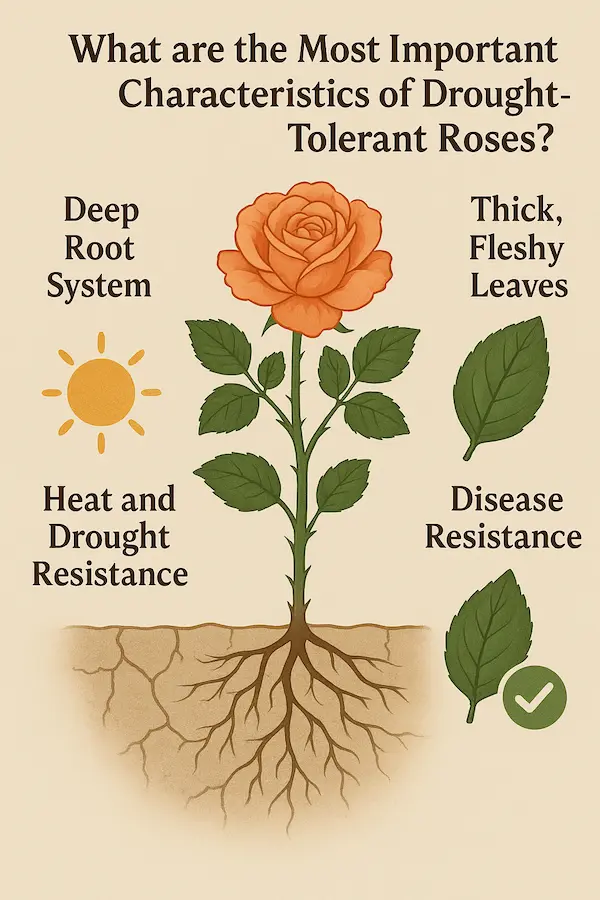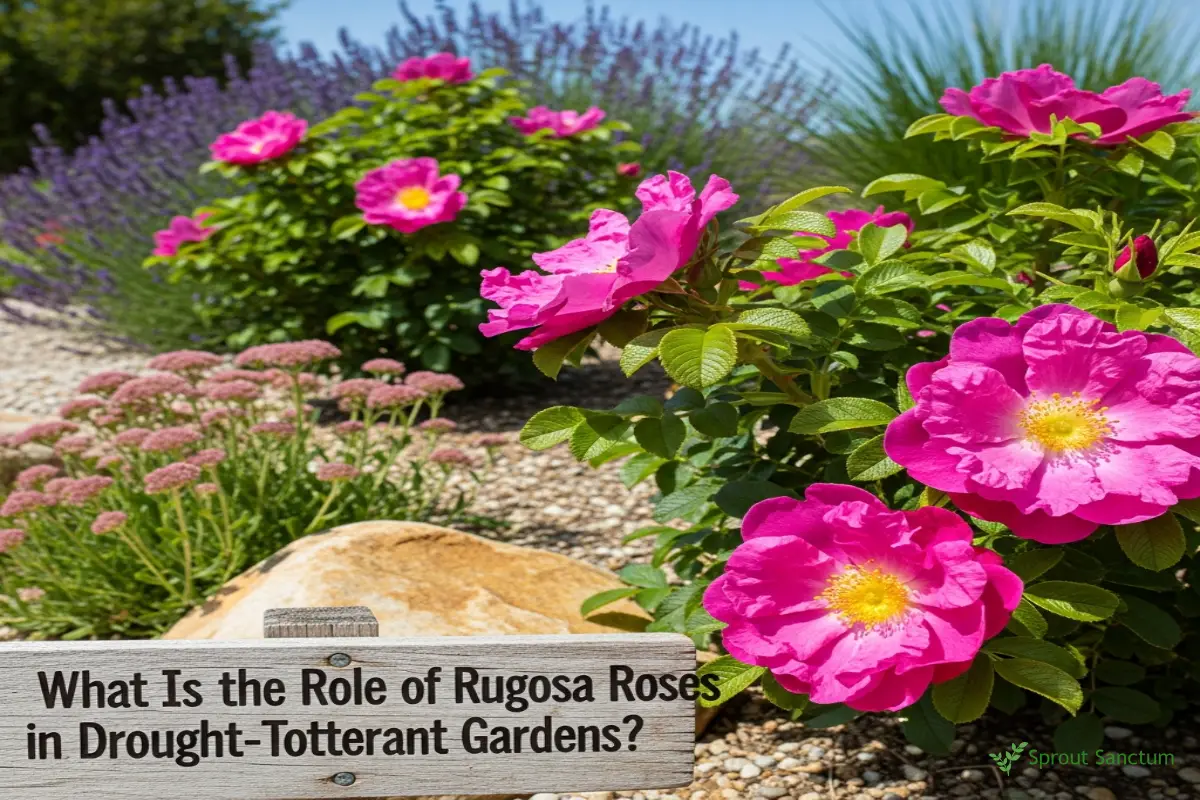Discover the Best Drought-Tolerant Roses: Beautiful, Resilient, and Perfect for Your Garden

03
Apr
Apr
Do you love roses but are concerned about maintaining them in dry climates? Do you reside in dry regions or just desire to save water for your garden? Drought-tolerant roses provide the best answer. These low-water, high-strength roses are ideal for adding to gardens that require lovely flowers without the ongoing necessity for watering. In this post, we will discuss the best drought-tolerant roses, including David Austin roses, and how they are heat-tolerant, drought-tolerant, and even tolerant of extreme weather.
Contents
hide
Why You Should Grow Drought-Tolerant Roses
Should you love roses but reside in a water-conscious or arid climate, then drought-tolerant roses are a godsend. Drought-tolerant roses supply beauty and function, making them a must for any low-water garden.
Drought-tolerant roses, like the Coral Drift® and other resilient varieties, bloom abundantly with minimal care. And as an added benefit, they’re also highly disease-resistant, making them perfect for novice and experienced gardeners alike. Here’s how to sort through the top drought-tolerant rose varieties, their care, and why they’re the perfect fit for today’s water-wise gardening.

What Are Drought-Tolerant Roses?
Drought roses are especially designed to be resistant to dryness and require less water than other rose varieties. Drought roses have adapted to conserve water so that they can live and thrive in arid environments or low-rainfall areas. Unlike ordinary roses that may require frequent watering, drought roses can cope with minimal irrigation and hence are ideal for water-saving gardens.
These roses usually originate from more robust rose species such as the Rugosa or China rose. They are able to thrive in dry conditions since they have deep roots and fleshy, waxy leaves that minimize water loss. Most of these roses also have enhanced disease resistance, which makes them ideal for gardeners who want lovely flowers without the stress of continuous maintenance.
How Do Drought-Tolerant Roses Survive Dry Spells?
Drought-tolerant roses have developed some properties that enable them to survive on minimal water. One of their most significant properties is that they possess a deep root system. These roots can extend far into the soil to access groundwater tables, enabling the plant to receive water even when the surface soil is dry.
Also, the majority of the drought-resistant roses have leathery leaves with a thick covering that reduces water loss via transpiration. This process becomes extremely significant when water is scarce. The fact that the rose has a water-saving mechanism, along with the deep-root system, ensures the plant can survive extended periods without watering, and thus it is a particularly precious resource to gardeners residing in arid regions or who desire to save water.

Which Rose Varieties Are Suitable for Drought Resistance?
David Austin roses are some of the most drought-resistant rose types. With their beautiful, scented flowers and distinctive English rose features, these roses have also been developed to be resilient in adverse conditions. David Austin roses are ideal for dry climates since they provide beauty and endurance.
A few of the other great drought-tolerant rose varieties are the Coral Drift® and the Rugosa rose. The Coral Drift® rose is a low-maintenance, disease-resistant rose that also features semi-double flowers, so it’s a great option for a low-water landscape. Rugosa roses, which tolerate dry, salty soil, are another great option. They feature beautiful flowers and pretty, glossy leaves, so they would thrive even in locations that experience drought.

What are the Most Important Characteristics of Drought-Tolerant Roses?
These drought-tolerant roses possess several important characteristics that make them perfect for water-saving gardens. In the first place, they are extremely drought-tolerant. They thrive under conditions where ordinary roses would not due to their deep roots and low water use.
Many of the drought-tolerant roses also have excellent disease resistance, which is especially helpful in hot, dry conditions when disease and pests are generally more of an issue. And as the icing on the cake, the drought-tolerant roses also often have gorgeous flowers, in shades ranging from apricot and coral to pink, yellow, and white. Some of the drought-tolerant roses, such as the semi-doubles, even offer an extra bonus of texture and visual interest in the garden.

Do Drought-Tolerant Roses Perform Well in Small Gardens?
In fact, drought-tolerant roses are quite suitable for small spaces. Compact growth habits allow them to perform well in city gardens, patios, and containers. The Coral Drift® and the semi-double blooms of some David Austin roses are excellent examples of drought-tolerant roses that are perfect for creating a statement in small space. These roses can even be used as ground covers or low hedges, adding color and texture without taking up too much room.
Small gardens can take advantage of the low watering requirement of the drought-tolerant rose. When well maintained, these roses will perform well with minimal water usage and space, which makes them perfect for any person with limited space for gardening.
What Is the Role of Rugosa Roses in Drought-Tolerant Gardens?
Rugosa roses are a classic favorite in dry gardens because they’re resilient and can cope with adverse conditions without hesitation. Rugosa roses have scented, large flowers and produce good growth. They can survive dry, salted soil and therefore are ideal for seaside or dry gardens.
Rugosa roses possess a wild, strange beauty with green foliage and a bushy, spreading habit. They are also great for achieving a natural, wild appearance in the garden. Rugosa roses, with their enhanced disease resistance and tolerance for limited water, are also a must in every low-maintenance, drought-tolerant garden.
Are Drought-Tolerant Roses Good Ground Cover?
Yes, all of the drought-tolerant roses make great ground cover. Ground cover roses are low-growing and spread rapidly to cover the soil and prevent erosion and weeds. Some varieties, such as the Coral Drift®, spread quite rapidly while still being neat and tidy in appearance.
Ground cover roses are also especially handy where you want to conserve water and reduce the level of ongoing maintenance. Having the capability to thrive with little water while still blanketing the ground with beautiful flowers makes them a great contender to be included in any dry garden.
Some of the Most Scented Drought-Tolerant Roses Are
Although the majority of drought-tolerant roses are known to be hardy and have low water needs, they can also be extremely fragrant. For instance, David Austin roses are well known for their highly scented, lush flowers. These roses offer a wide range of color and perfume, from sweet, old-rose fragrances to more modern, fruity perfumes.
Other roses that are drought-resistant, like the Rugosa rose, also possess a powerful scent. These fragrant roses not only add visual appeal but also pollinator appeal in the way of bees and butterflies, so they are an excellent choice for creating a garden that is beautiful and eco-friendly.
How Do You Take Care of Drought-Tolerant Roses During Severe Heat?
Even drought-tolerant roses require a little care during very hot weather. While these roses are hardier than old roses, they still appreciate some tender loving care when there is a heatwave. Mulching around the plant base will retain soil moisture and keep the roots from drying out. Planting the roses in well-draining earth will also keep root rot at bay when the weather is very hot.
Pruning is also a significant task in ensuring the well-being of drought-tolerant roses. The removal of dead or injured plant material can provide the plant with its opportunity to redirect its efforts at blooming profusely. Lastly, occasional but deep watering will work best to provide the roses with the required water without causing shallow rooting.
What Are the Advantages of Having Low-Maintenance Roses in Your Garden?
The low-maintenance roses are perfect for gardeners who want to enjoy beautiful flowers without spending too much time on maintenance. Drought-tolerant roses are generally easier to care for compared to traditional roses because they require less water and are also less prone to disease and pests. They are perfect for busy gardeners or gardeners who want to conserve water.
Low-maintenance roses also equate to less pruning, less fertilizing, and less effort overall. Whether you need a rose to squeeze into a small area or a type to fill up more space, there are drought-tolerant roses that will do the trick with less effort. Key Takeaways Drought-tolerant roses such as David Austin roses and Rugosa roses are ideal for dry gardens and low-water landscapes. These roses have deep and water-conserving root systems and thick leaf systems. Cultivars like the Coral Drift® do well in compact areas, ground cover, and creating stunning visual effects.
Drought-tolerant roses provide stunning, scented flowers with excellent disease resistance and are an excellent choice for low-maintenance plants. To maintain drought-tolerant roses, mulch, water well, and prune as required, particularly in hot weather.
Planting drought-tolerant roses can save you water, labor, and time yet still reward you with beautiful outcomes in your garden. By planting drought-tolerant roses in your garden, you not only beautify it but also encourage environmentally friendly gardening.
Comparing the Best Drought-Tolerant Roses for Water-Wise Gardens
If you love roses but live in a dry climate, drought-tolerant roses offer the perfect solution. These beautiful blooms require minimal water, are disease-resistant, and thrive in harsh conditions, making them ideal for low-water gardens. This table compares various drought-tolerant rose varieties, such as David Austin roses, Coral Drift®, and Rugosa roses. These roses not only provide stunning flowers and fragrances but also grow well in water-scarce environments, with low maintenance needs. By choosing the right variety, you can enjoy the beauty of roses while conserving water and minimizing upkeep.
| Rose Variety | Drought Tolerance | Disease Resistance | Watering Needs | Growth Habit | Fragrance | Best For |
|---|---|---|---|---|---|---|
| David Austin Roses | High | High | Low | Bushy, Upright | Highly fragrant (old-rose & fruity) | Dry gardens, low-maintenance, fragrance lovers |
| Coral Drift® | High | High | Low | Compact, Ground cover | Lightly fragrant | Small spaces, ground cover, low-water gardens |
| Rugosa Roses | Very High | Very High | Very Low | Bushy, Spreading | Strongly fragrant | Coastal gardens, wild, drought-prone areas |
| Semi-Double David Austin Roses | High | High | Low | Compact, Bushy | Fragrant (old-rose & fruity) | Small spaces, visual appeal, low-water gardens |
In case you are interested in learning more about cultivating drought-tolerant plants and flowers, be sure to check out Sprout Sanctum. On this site, you can get tips and informative guides on how to develop a beautiful, drought-tolerant garden. Through experts’ tips, you can cultivate beautiful, low-maintenance flowers and have a beautiful garden that survives on little water.

